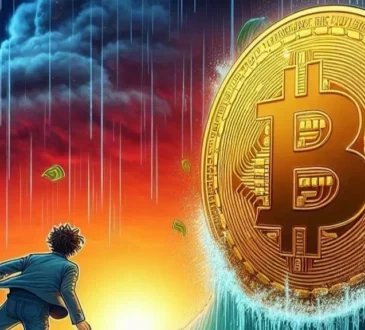Young woman buying in supermarket and feeling worried about increase in food prices.
getty
(Full disclosure: I’m helping build Coinbits.app, a bitcoin banking platform.)
When a currency loses purchasing power at a rate greater than 50% per month, it is said to be experiencing hyperinflation. During such episodes, the essential role of money in binding society together, often unnoticed in stable times, becomes strikingly clear as civil order is strained or even shattered.
The breakdown of the monetary system leads to widespread economic turmoil, affecting every facet of daily life, from the affordability of basic goods to the stability of institutions. In the most serious cases of total currency collapse, civil unrest and even violence become prevalent among a population desperate to acquire the necessities to survive.
Although the United States has faced severe inflation in its history, it has never endured hyperinflation. However, it would be incorrect to assume that Americans have no experience with it, as many immigrants or those who spend significant time overseas have lived through such periods. People often immigrate to the U.S. driven by problems in their home countries, and many of these problems have a common root cause: broken money.
Nobody knows this better than my friend Tony Yazbeck, who endured Lebanon’s hyperinflation a few years ago and lost his life savings. (Full disclosure: Tony and I are collaborating to help people protect their wealth with bitcoin.)
“Living through a currency collapse is not something anyone wants to experience. In Lebanon, I went from a successful entrepreneur enjoying early retirement to waking up with only $70 to my name almost overnight. When your currency fails, society completely falls apart and the consequences are extreme,” says Yazbeck.
In the past 50 years, at least 10 hyperinflation events have occurred, including in Zimbabwe, Yugoslavia, Venezuela, Argentina, Brazil, Nicaragua, Peru, Angola, and Lebanon. Looking at that list, it’s tempting to dismiss the possibility of hyperinflation affecting the U.S. dollar simply because all the countries on that list have developing economies.
However, no economy can overcome math. Any nation that debases its currency too much will need to pay the piper eventually. Since 1971, monetary expansion in the U.S. is over 8,252%.
M1 money supply over time, in billions of dollars. Since 1971, the supply of dollars has increased … [+]
Board of Governors of the Federal Reserve System (US)
Developed economies are not immune to hyperinflation. Lebanon stands out as a particularly relevant example. Although very different from the U.S. today, it was once considered the Switzerland of the Middle East, boasting a strong regional economy with Western-facing economic ties.
The rapid destruction of the Lebanese pound underscores how quickly hyperinflation can change the lives of regular people, even in “stable” economies.
In 2019, Lebanon’s economic crisis erupted due to decades of monetary expansion, corruption, and political instability. By 2020, the Lebanese pound had lost more than 80% of its value, and inflation soared above 85%.
“It’s hard to describe the feeling of losing everything,” remembers Mr. Yazbeck. “In Lebanon years of monetary expansion and corruption by the central bank destroyed the local currency and ruined the lives of an entire generation. It was utterly heartbreaking.”
The COVID-19 pandemic made the crisis worse, pushing the economy into a deeper abyss and highlighting how monetary debasement can quickly lead to hyperinflation and a breakdown in public services. Basic necessities such as food and medicine became unaffordable, leading to widespread poverty and social unrest.
Mr. Yazbeck still remembers the horror of seeing a currency crisis metastasize into social unrest and violence. “Watching ordinary people resort to crime and violence just to feed their children and care for sick relatives is the inevitable conclusion of a currency collapse. People are never prepared for it and the desperation leads to severe consequences.”
In the U.S., we now have alarming parallels: a national debt that is unfathomably high, runaway government spending, and an increasingly corrupt and ethically bankrupt political class.
To understand more specifically how the U.S. economy is exhibiting some of the same precursors to Lebanon’s collapse, we need to look at the root causes of inflation in more detail.
As Milton Friedman famously stated, “Inflation is always and everywhere a monetary phenomenon.” What he meant is that inflation is driven by expanding the money supply – and can only occur as a result of such expansions.
The money supply can expand for two main reasons: bank lending and fiscal deficit spending.
The inflation of the 1970s was driven by bank lending. As baby boomers grew up and sought mortgages, banks began lending at elevated levels. The resulting upward pressure on consumer prices was compounded by hard supply limits on key resources like oil. This period saw demand-pull inflation, where increased demand for goods and services pushed prices higher. The combination of easy credit and resource constraints created a perfect storm for inflation.
On the other hand, inflation driven by fiscal deficits occurs when a government consistently spends more than it earns in revenue, leading to large budget deficits. To finance these deficits, governments issue bonds, which are bought by the central bank or commercial banks. This expands the money supply because banks create new money, seemingly out of thin air, to purchase these bonds.
Persistent fiscal deficits can erode confidence in a country’s stewardship of its currency. This can lead to investors demanding higher interest rates to compensate for the increased risk of lending to a government addicted to debt. These higher rates increase borrowing costs across the economy, which then leads to cost-push inflation as businesses pass these costs on to consumers. Inflation driven by fiscal deficits is often considered the more insidious type because it erodes trust, which is very hard to recover once lost.
As we all know too well, the U.S. national debt has been on an upward trajectory, exceeding $30 trillion in 2023. This number is so enormous that it is hard to comprehend. Think of it this way: if you spent $40 million per day since year 0 A.D., you still would not have reached $30 trillion by today.
Additionally, the debt-to-GDP ratio now stands over 130%, a level historically associated with economic distress. Confidence in government bonds is being tested, and there will eventually be a breaking point. When that point comes, rapid currency devaluation will follow. We do not need to guess what will happen next – we only need to learn the recent history of Lebanon.
Hyperinflation is not just a theoretical risk confined to far-off nations. The precursors that lead to such crises are universal, and they are here. So, how can regular people protect themselves from currency debasement?
Historically, people have turned to gold, whose purchasing power has held relatively stable for thousands of years. However, for all its strengths, gold has a few significant drawbacks, not least of which is that you can’t send it over the internet. Gold is ill-suited to a mobile, global economy. With gold, you cannot easily flee across borders carrying your life savings, nor can you send it to help friends or relatives abroad who are facing a crisis.
For our globally connected, digital economy, bitcoin provides some of the same protection from currency crises. Like gold, bitcoin is absolutely scarce. Although it does not have gold’s long history, people are using it to escape failing economies.
Mr. Yazbeck agrees. After picking up the pieces of his former life in Lebanon, he founded The Bitcoin Way, which is focused on helping people learn to use bitcoin to protect themselves. “Bitcoin is the only hard asset that can easily cross borders and that you can take complete ownership over. Had I known about it earlier I would have been able to use it to completely avoid the financial meltdown in Lebanon. Having lived through the problems first hand and then discovering the solution, I now make it my life’s work to educate and inform others.”




